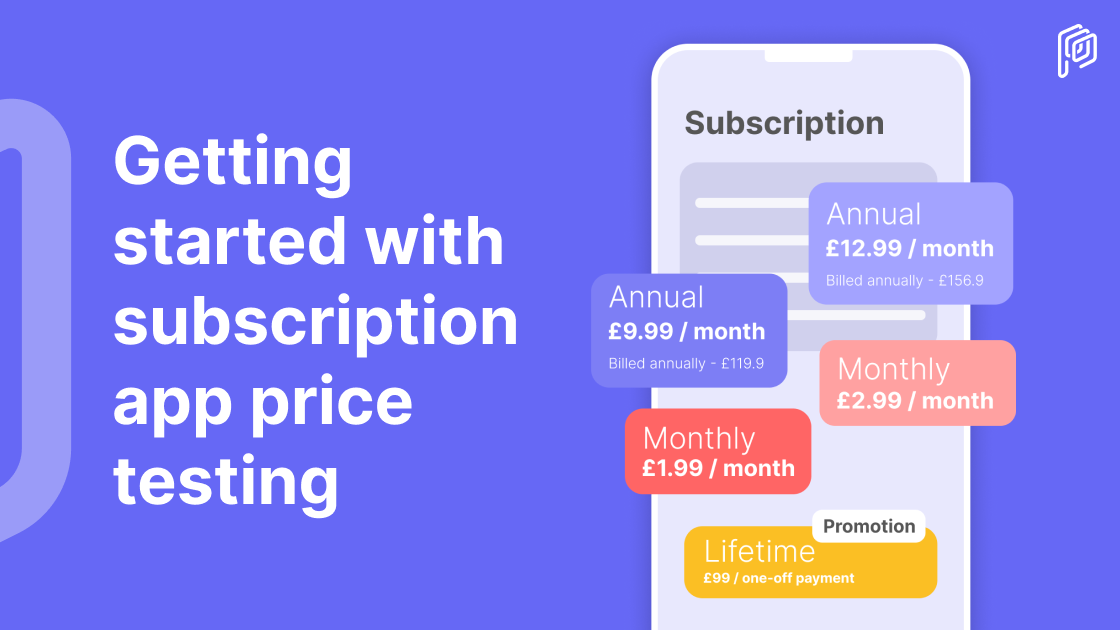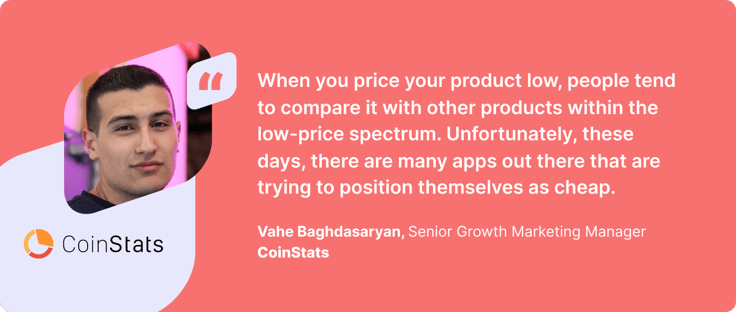Advanced Segmentation to Increase LTV
13 March 2025
Customers Case Study Paywall A/B Testing Conversion Price Testing Mobile APPBoost LTV with advanced segmentation. See how top apps tailor pricing & messaging to drive conversions.
Get our latest resource
8 app onboarding flows defining 2026
We analyzed 8 top-performing apps — TikTok, Wise, Nike, Expedia, Fitbit, Strava, Pinterest, and Flo — to uncover the patterns shaping 2026’s best onboarding experiences.
This playbook reveals the patterns shaping next-gen onboarding — what works, why it works, and how you can apply it to your own experience.

Bomee Lafitte
Content Marketing Manager @ Purchasely
It is widely acknowledged among businesses that overlooking the importance of pricing strategy can result in missed opportunities to maximize revenue potential. This is particularly crucial in the competitive world of mobile apps, where even a cent difference in pricing can sway user decisions. Pricing is recognized as a fate-changing factor that directly affects an app's profitability.
1. Tailoring your pricing strategy
2. Why subscription app price testing is essential
3. When to run price testing
4. What to test
5. Guiding principles for running effective price tests
6. Run your price A/B tests with Purchasely
To demonstrate the significant influence pricing can have on user behavior and profit margins, let's explore the findings of a recent A/B test conducted by a leading parental control utility app. The test leveraged Purchasely's no-code testing tool, enabling precise evaluation of different pricing scenarios.
A Purchasely price test demonstrated that a slightly higher price proposed to users in Canada led to significantly increased conversion and revenue.
The objective of the test was to boost conversion to an annual subscription and to see the price sensitivity of a specific user segment: users based in Canada using an iPhone.
Target users were given a choice between two price variants for the annual plan: one set at £2.58 and the other set at £2.92. Additionally, both variants were offered alongside a lifetime access option.
Intuitively, one might assume that the lower price would attract more users and result in higher conversions. However, surprisingly, when the price was set slightly higher, the rate of paid subscriptions more than doubled, and the revenue generated almost tripled.
This example illustrates how even a slight variation in price can profoundly impact revenue, particularly in an unexpected manner.
Another compelling illustration comes from CoinStats, a well-known cryptocurrency platform. They adopted a contrasting approach that underlines the significance of tailoring pricing strategies to suit individual apps. Instead of conducting a test with two closely related price variations, they opted to examine the effect of a substantial price disparity between $41.99 and $119.99. Surprisingly, the outcome of this two-month experiment revealed that the higher-priced package, priced at $119.99, attracted twice as many customers.
As these two examples demonstrate, today, many apps are adopting price testing to eliminate the old copy-pasting strategy or guesswork from their growth strategies.

Vehe Baghdasaryan, Senior Growth Marketing Manager at CoinStats on positioning the app within the right price spectrum.
Lower prices may drive more sales but can result in an increase in low-fidelity sales and a loss of revenue per sale. Higher price points could impact customer perception of value. Price positioning can also have a significant impact on your app's market position and overall attractiveness, influencing users' appetite for your app's value even before they have a chance to experience it firsthand.
To help you begin your price testing journey on a solid foundation, this article will explore the following topics:
We will also introduce Purchasely's seamless price testing feature, designed to help subscription apps find that lucrative sweet spot.
Price is one of the key pillars of the marketing mix. Marketers must decide on the price of a product or service after its development. Presently, pricing is a challenging decision for marketers as it greatly affects customer perception of value and the company's profits. Poor pricing choices can immediately and severely impact profits, making recovery difficult. Pricing decisions should align with the actual and perceived value of the product or service, while also taking into account competition, supply costs, and timing of discounts.
Relying solely on assumptions or intuition when determining the right price for your subscription offerings can be risky. Read on to understand why price testing is crucial for subscription apps and how it can help build a data-driven approach to finding an effective pricing strategy.
Price testing enables you to assess whether your app's pricing aligns with the preferences and expectations of your target market and the specific app category it belongs to. It offers a valuable opportunity to gauge your app's position in the market by evaluating how your app's value is perceived in monetary terms, relative to your competitors.
Setting prices low may attract a large customer base, but it can also lead to a decline in revenue per sale. Conversely, a high price point may maximize profitability per sale, but it runs the risk of deterring potential customers who perceive a lack of value for their investment.
Price testing allows you to experiment with different price points and carefully observe customer responses. By analyzing the data gathered from these tests, you can identify the pricing strategy that strikes the perfect balance between revenue generation and app user satisfaction.
Not all customers have the same price sensitivity. Different customer segments may have varying perceptions of value and different willingness to pay for your app's features. Price testing enables you to understand how these segments respond to different pricing options. By segmenting your customer base and conducting targeted price tests, you can gain insights into the price sensitivity of each segment. This information empowers you to tailor your pricing strategies to specific customer groups, enhancing customer satisfaction and loyalty.
Determining the right timing for price testing is crucial for subscription apps seeking to optimize their pricing strategies. Here are several key scenarios when conducting price tests is particularly beneficial:
Price testing during the initial launch of a new product allows you to gauge the market's response and make necessary adjustments early on. By testing different price points, you can assess customer reactions and fine-tune your pricing strategy from the very beginning, setting a solid foundation for future growth.
When starting to acquire new users in a different country, you can tailor the pricing strategy to suit the preferences and purchasing power of subscribers in the target market by offering territory-specific prices in different currencies.
If your competitors modify their prices, it's a good time for you to conduct price tests on your app to evaluate the optimal response. Testing different pricing scenarios helps you understand how your users react to those alternative prices and determine the most effective strategy to maintain a competitive edge.
When experiencing increased costs in areas such as production, marketing, or maintenance, price testing can provide valuable insights into the feasibility of passing those costs onto customers. By experimenting with different price points, you can evaluate customer responses and determine the viability of adjusting prices to maintain profitability while balancing customer satisfaction.
Whenever you introduce new features or make changes to your subscription plans, conducting price testing becomes essential. Price testing ensures that your pricing aligns with the value provided by your app as well as the investment put into it. By testing different pricing strategies, you can assess customers' perception of value and adjust prices accordingly. This helps maintain a fair pricing structure and ensures that customers continue to view your app as a valuable investment.
Price testing extends beyond simple observation of Price A and Price B. To enhance pricing strategies for subscription apps, it is crucial to take into account a range of important factors during price testing. Here are three specific elements to test:
Subscription durations: Testing different subscription durations, such as monthly, quarterly, and annual options, can help identify the most attractive and profitable choices for customers.
Target segments: Exploring pricing variations for different customer segments is crucial. By understanding and catering to the different price sensitivity and willingness to pay within each segment, you can increase the chances of capturing more users’ attention and driving higher conversions.
Product or plan: You can test different subscription tiers or bundles to ensure that customers can choose the plan that best aligns with their needs and budget while maximizing the value they perceive from your app.
Rounded prices: Apps can assess user’s purchasing decisions by examining the effects of rounded prices such as $40 instead of $39.99. This approach has gained attention with the introduction of new tiers by Apple, which enable businesses to implement rounded pricing strategies.
Trial duration: When deciding on the trial length, factors such as the learning curve and discovery time of the app should be considered. By experimenting with various trial lengths, you can identify which duration retains and converts users most effectively, ultimately leading to increased revenue generation.
If you have access to an advanced monetization testing tool like Purchasely, you can go the extra mile and skillfully manage multiple customizable elements for testing, enabling you to fine-tune your pricing strategy. Here are the elements you can customize and test when utilizing Purchasely.
Now that we have discussed the why, when, and what of price testing, let's explore the hows. To ensure effective results from your subscription app's price tests, we recommend focusing on the following key considerations as guiding principles.
To obtain better and more accurate data from price A/B tests, it is crucial to allow tests to run for an extended period. By leveraging an adequate number of paywall views and gathering a larger sample size, you can obtain more robust and conclusive findings that closely resonate with user behavior and preference trends.
Make sure to avoid the risk of any other factors affecting your test results. For example, avoid running the test at the same time as a major acquisition campaign. You won’t be able to determine if the additional conversion or revenue came from the price change or the marketing efforts.
Iterative testing is essential when refining your pricing strategy. Don't be afraid to test different price points, durations, or subscription tiers multiple times until you find the optimal configuration. Analyze the data gathered from each test and use it to inform subsequent iterations. Through continuous testing and adjustment, you can fine-tune your pricing strategy and increase your chances of finding the perfect price point that resonates with your target market.
When designing price tests, it's crucial to ensure they accurately reflect real-world scenarios. Instead of solely focusing on user acquisition and retention efforts, consider realistic factors such as production costs, market demand, inflation, and competitive pricing. By taking these realistic elements into consideration, you can run price tests that align with your revenue goals and contribute to the long-term sustainability of your app. Besides, "cheap" doesn't always mean "more customers" because customers may as well perceive a cheap price as indicative of a lower quality or service.
When implementing price changes for your tests, it's crucial to consider the impact on your existing customer base. Avoid making drastic price adjustments that may alienate or frustrate your current users. Instead, consider strategies like grandfathering, where existing customers continue to enjoy their current pricing while new customers face the updated pricing. Additionally, offering incentives or additional value during price transitions can help maintain customer loyalty and mitigate any negative sentiment.
It is important to look beyond simply adjusting the price point. Consider strategically leveraging promotional offers and introducing additional consumable packages. By adopting an approach that extends beyond simply offering discounts or raising prices, you can generate additional revenue streams alongside the recurring ones, while increasing the lifetime value (LTV) of users. It can help foster long-term relationships with your customers and fortify engagement.
There are a handful of risks associated with subscription app price testing including technical glitches or display errors that may disrupt the user experience, non-compliance with app store regulations leading to app rejection, and the time and financial time investment put into planning, executing, and analyzing the results.
To streamline the price testing process and make it a seamless part of your business operations, consider leveraging growth platforms like Purchasely. With its advanced features tailored for price testing and paywall iteration without the need for coding, Purchasely empowers you to save valuable time and effort. By harnessing the capabilities of the right tool, you can conduct price tests efficiently and make well-informed, data-driven decisions that optimize your pricing strategy.
To streamline the price testing process and make it a seamless part of your business operations, consider leveraging growth platforms like Purchasely.
With its advanced features tailored for price testing and paywall iteration without the need for coding, Purchasely empowers you to save valuable time and effort. By harnessing the capabilities of the right tool, you can conduct price tests efficiently and make well-informed, data-driven decisions that optimize your pricing strategy.
13 March 2025
Customers Case Study Paywall A/B Testing Conversion Price Testing Mobile APPBoost LTV with advanced segmentation. See how top apps tailor pricing & messaging to drive conversions.
Jason Gossett
18 July 2023
Paywall A/B Testing App Pricing Price TestingLearn how inflation impacts subscription prices (software, apps, streaming) and learn how the A/B price test helps navigate through the changing...

Bomee Lafitte
Content Marketing Manager @ Purchasely
19 June 2023
Paywall A/B Testing App Pricing Price TestingPrice A/B testing with Purchasely: Why, when, what, and how.

Bomee Lafitte
Content Marketing Manager @ Purchasely